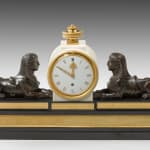Patinated and Gilt Bronze Mounted Marble Mantel Timepiece
ENGLAND, 1806
25 x 42 x 8.5 cm
Further images
Literature
The Vulliamy Records published by The Vulliamy Company, 1797 – held by the British Horological Institute. The Vulliamy Records consist of twelve hand written bound volumes and a small packet of loose papers. Two volumes are lists of clocks made and supplied and this clock appears in Vol 1, 20th March 1797 to 29th April 1809, clocks nos 296-489.The National Archives, C104/58, Vulliamy Day Book 34.
The fluted white marble drum case surmounted by a reeded urn finial and flanked either side by a recumbent sphinx, each mounted on black marble plinth inset with a gilt plaque enriched with stylised foliate motifs, raised on stepped base inset with a matted bronze panel with reeded border, the 3 3/8th inch enamel Roman dial with an bezel cast as Ouroboros, gilt numerals, scroll hands and regulation arbour at XII, the signed and numbered single fusee movement with rise and fall regulation, numbered pendulum with steel rod, the circular plates united by four tapered pillars and supporting the characteristic back cock.
Benjamin Vulliamy (1747-1811): was the son of Justin Vulliamy, a clockmaker of Swiss origin, who moved to London around 1730. He developed a reputation as a builder of mantel clocks and his talent earned him a Royal Appointment in 1773, through which he received an annual endowment of £150 as George III’s King Clockmaker. This is one of a number of clocks with sphinxes in the Egyptian taste that were designed and made by Vulliamy around 1800. They were made to three different designs over a relatively short period. At this time, Egypt had risen to prominence due to Napoleon’s campaign in Egypt from 1798-1801 which lead to Nelson’s victory at the Nile in 1798. Subsequently, there was a great survey and publication of Egyptian antiquities by Dominique Vivant Denon, making the symbols of Ancient Egypt highly fashionable across Europe.
Vulliamy’s first design is ornamented with two sphinxes, an eagle and a large Wedgwood medallion: there is an example dating from 1799 in the British Museum (No. 308). His third design, which is in a more highly developed Egyptian style based directly on the illustrations in Denon’s book, uses four sphinxes of a different and smaller model, as well as other ornamental mounts taken from Denon. An example is No. 438, now in the Victoria and Albert Museum, which was made in 1807-08.
Vulliamy No. 407 is an example of Vulliamy’s second design and was completed in 1806. It uses the same model of sphinx as the first type, but with some modifications, including a tail. In this form, the sphinxes replace the more familiar pair of lions which Vulliamy used on many of his ornamental clocks of this period, in a style recalling the imperial grandeur of Rome, rather than the “Greek” neo-classicism of his earlier ornamental clocks with figures in biscuit porcelain.
Vulliamy’s business records reveal that he used his usual network of independent craftsmen to make this clock. They included Houle for casting and chasing the two sphinxes at a cost of £4 and the clockmaker Jackson for the movement for which he charged £5-10s. The largest individual item was the marble case, which was supplied by Day for £7-7s. The clock was delivered to Miss Bull on 28th March 1806 for the considerable sum of 50 guineas (£52-10s). Five years later, on 11th December 1811, it was returned to Vulliamy to be cleaned and fitted with a “new enamel dial with gold hours” – presumably the one it still has. The customer was a Mrs. Gordon, who was perhaps the former Miss Bull or a relative.
For Vulliamy’s personal involvement in the design of his ornamental clocks, see R. Smith, ‘”It is not in the power of porcelain to be commanded”: some problems in the design and manufacture of Vulliamy’s sculptural clocks,’ in T. Walford and H. Young (eds), British Ceramic Design, 1600-2002, (ECC 2003).
D. Vivant Denon, Voyage dans la Basse et la Haute Egypte, (London 1802).
The British Museum clock (Museum number: 1909,1201.13) is illustrated on the British Museum website.
The Victoria and Albert Museum clock (Museum number: M.119:1 to 3-1966) is illustrated on the museum’s website.
See The Age of Matthew Boulton, Mallett, 2000, p.90 for a sphinx clock by Vulliamy of similar design.














